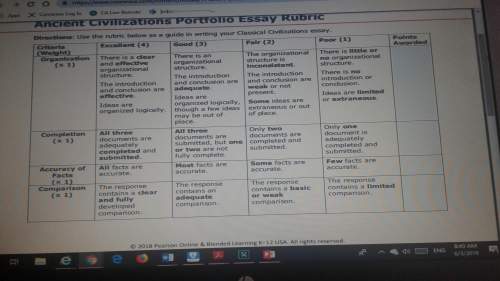
History, 16.08.2020 02:01 residentevil7k
WILL GIVE 100 POINTS AND BRAINLEST TO FIRST PERSON WHO ANSWERS CORRETCLY NEED ANSWER ASAP How did the agricultural revolution impact early humans? Early humans were resourceful in tracking herds. Early humans had to find their food from season to season. Early humans had to focus all their energy on producing food. Early humans did not have to follow their food source from place to place. What led to early villages evolving into complex societies? NEED ANSWER ASAP 2. People specialized in tasks that helped with food production and hunting. When bad weather caused flooding, people could build new structures in a new location. When food was in short supply, farmers could go to special storage areas and distribute food to the most useful people. The climate and reliable water supply resulted in food surpluses that were used for growth and trade with other villages. 3.How did the environments of early agricultural societies impact early villagers’ diets? Farmers began to grow better crops, so villagers ate better quality food. Farmers struggled to vary their crops, so villagers ate one type of food. Farmers developed techniques to grow crops in high altitude mountain regions. Farmers could not reach water sources, so villagers had limited food during droughts. 4.How were the different stages of society organized over time? Nomadic clans grew into civilizations when they learned to form permanent villages. Villages formed as a result of the advanced techniques of nomadic hunting by clans. Complex civilizations included clans that followed the herds for food from place to place. Complex villages were the most advanced form of people living together as they hunted from place to place. 5.How did the environment enable agricultural societies to trade? Early societies learned to rely on other villages for food when their crops failed. Early societies developed crops to trade with to take control of new trade routes. Early societies that developed a food surplus could trade with neighboring villages. Early societies created trading posts out of temporary shelters for hunting and fishing. 6.Which was a challenge for the earliest permanent settlements? Flooding allowed villagers to expand their property. Fire risk increased due to the closeness of buildings. Disease was a threat because of the close proximity to the rivers. Droughts were a challenge that villagers overcame with technology. 7.Which shows a major change from early settlements to complex societies? The trade or barter system disappeared under the growth of complex societies. Animism became the main religious practice as villages became complex societies. Specialized skilled workers became obsolete as complex societies grew and traded with neighbors. Clan or family leadership evolved to village or town leadership, which made laws and maintained order. 8.How did the development of permanent settlements change the types of buildings that were needed? Settlements encouraged families to live separately to dominate the resources in a crowded village. Settlements required buildings that could hold larger amounts of people for meetings and other gatherings. Settlements were designed with materials that could be taken apart quickly to follow herds in other locations. Settlements were built with wide open spaces to provide ample room for religious and government buildings. 9.The image shows a piece of art found at the Catal Huyuk site in Turkey. A stone sculpture of 2 human figures. Detailed facial and body features are visible. Why is it reasonable to conclude that this piece of art was produced in a settled agricultural society rather than a hunter-gatherer tribe? Only an artist with a lot of skill and advanced tools could create this statue from stone. Artists in permanent settlements were limited in using only certain tools to create their art. Only an artist with simple skills in representing the human form could produce this figure of stone. Artists in agricultural societies had limited access to resources other than stone for their works of art. 10.The dark shaded areas of the map show early agricultural sites and the light shaded band shows warmer climate areas. A map titled Agricultural Sites circa 8000 to 3000 B C E. The light shaded band shows warmer climate areas. Cooler climate areas are above and below the warmer climate areas. Agricultural sites are shaded within the warmer climate areas. What do the dark shaded areas suggest about the agricultural revolution? People lived in cooler climates to hunt. People lived in warm climates to grow food. People lived mostly in Africa to farm and hunt for food. People lived in all parts of the world regardless of climate.

Answers: 2


Other questions on the subject: History

History, 22.06.2019 03:00, marykayy0218own5cp
Why did reagan have the united stars invade grenada
Answers: 2

History, 22.06.2019 06:30, lexas2894
In this activity, you’ll read and analyze the song “the unreconstructed rebel,” written around 1866. you’ll draw conclusions from this song about southerners’ feelings toward african americans after the civil war. part a who is the speaker or the singer of the song? how do you know?
Answers: 2

History, 22.06.2019 07:30, dillon3466
What role does an american citizen play in its own government ?
Answers: 1

History, 22.06.2019 08:30, reycaden
How did the mexican war of independence differ from the american revolution? o a. only the american revolution was concerned with establishing a representative form of government. o b. only the mexican war of independence required military conflict to achieve its objectives. o c. only the american revolution succeeded in replacing a monarchy with another form of government. o d. only the mexican war of independence eliminated spanish colonial control over part of north america.
Answers: 1
You know the right answer?
WILL GIVE 100 POINTS AND BRAINLEST TO FIRST PERSON WHO ANSWERS CORRETCLY NEED ANSWER ASAP How did th...
Questions in other subjects:

Computers and Technology, 12.07.2019 17:10

Mathematics, 12.07.2019 17:10












